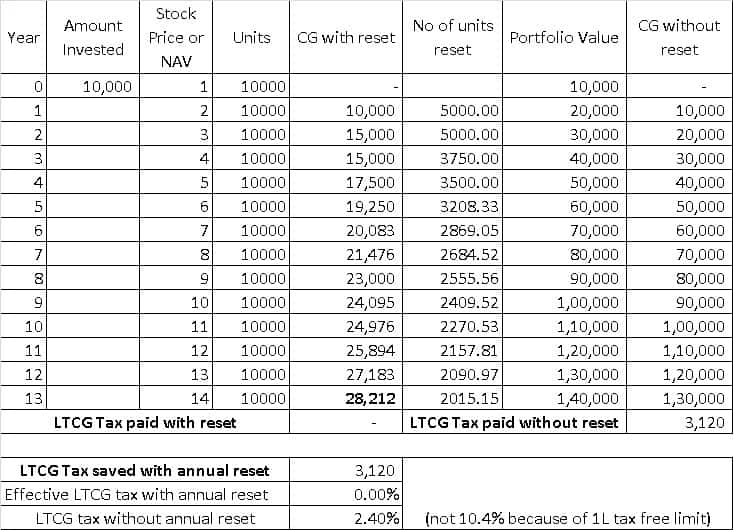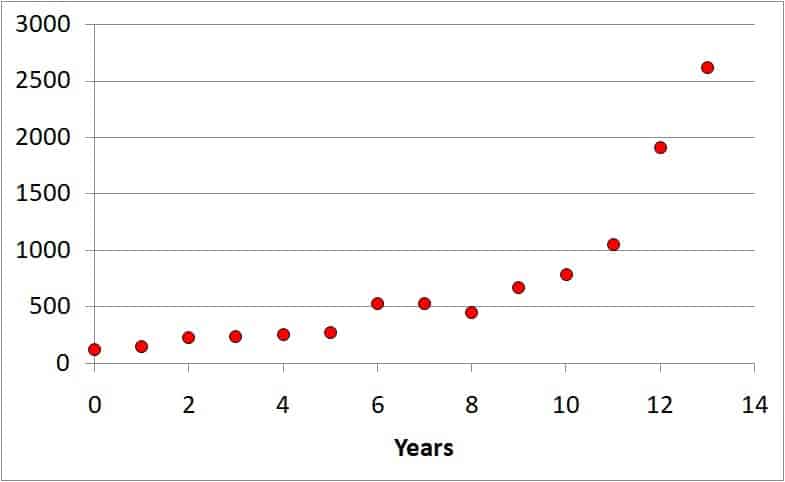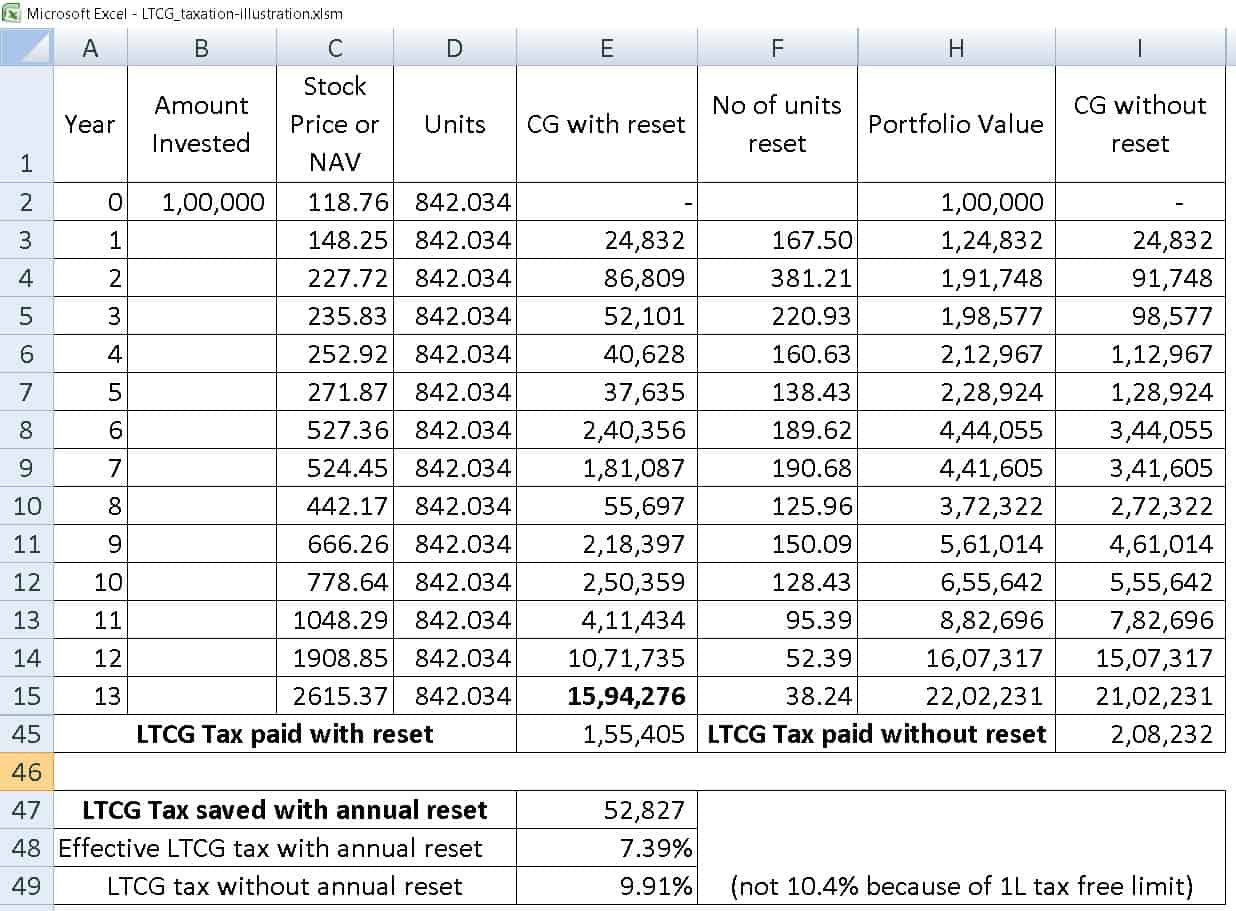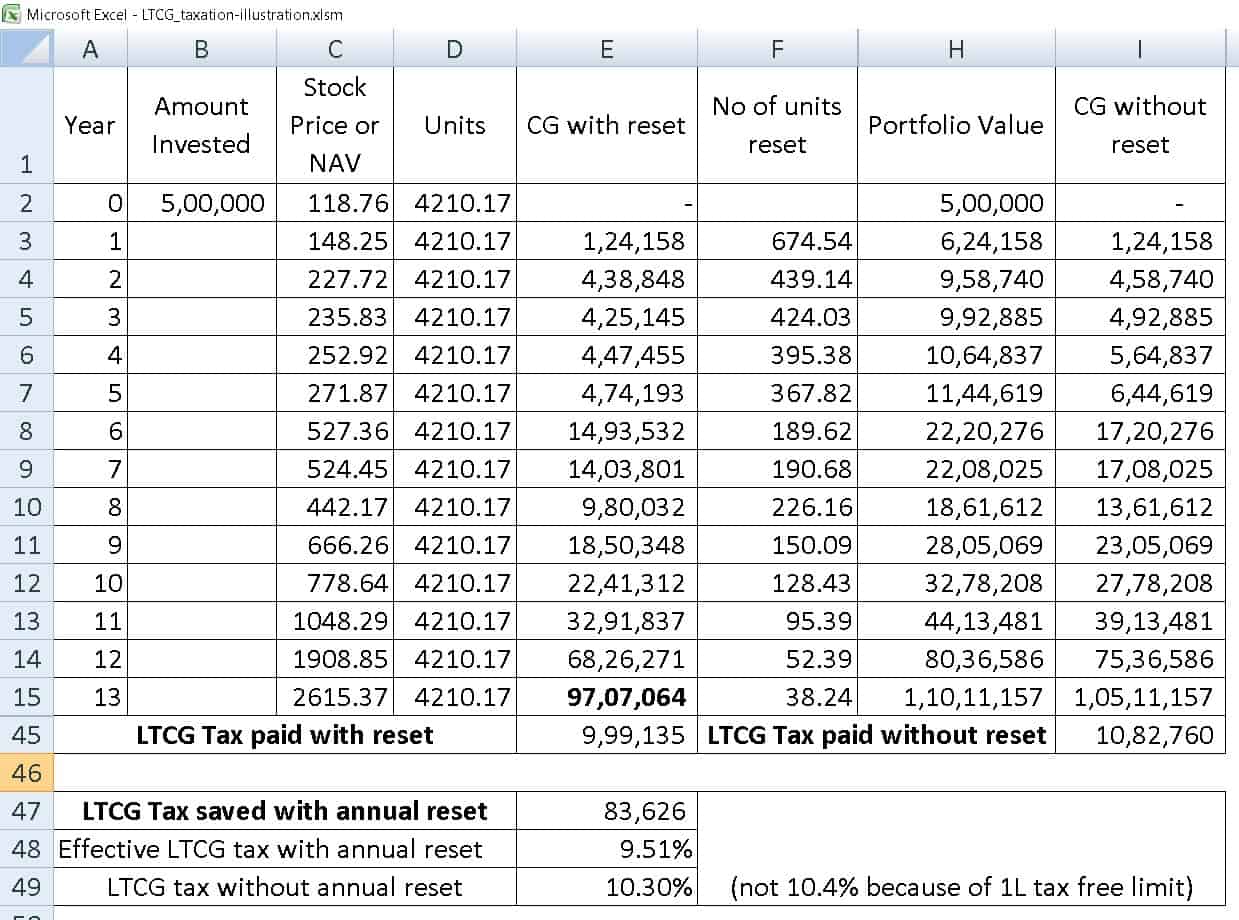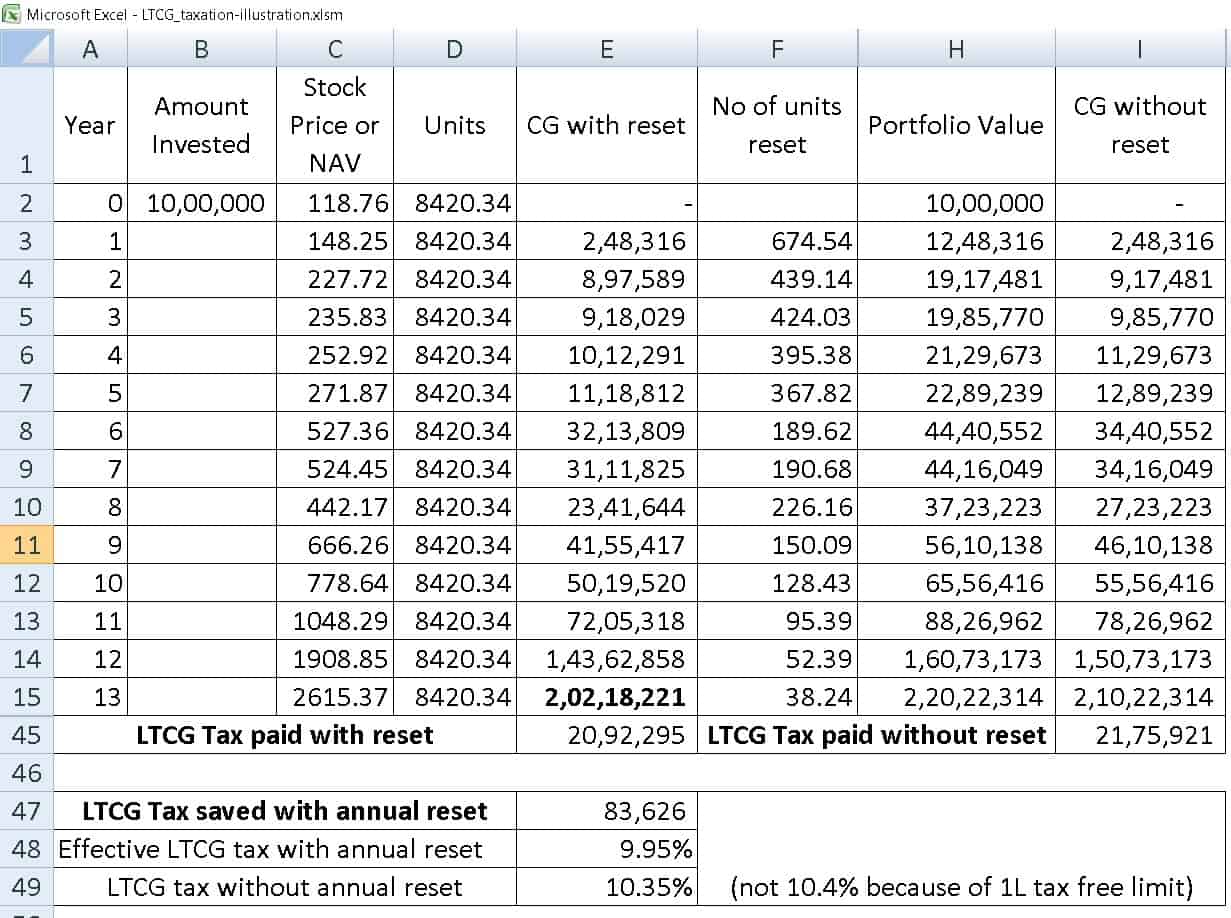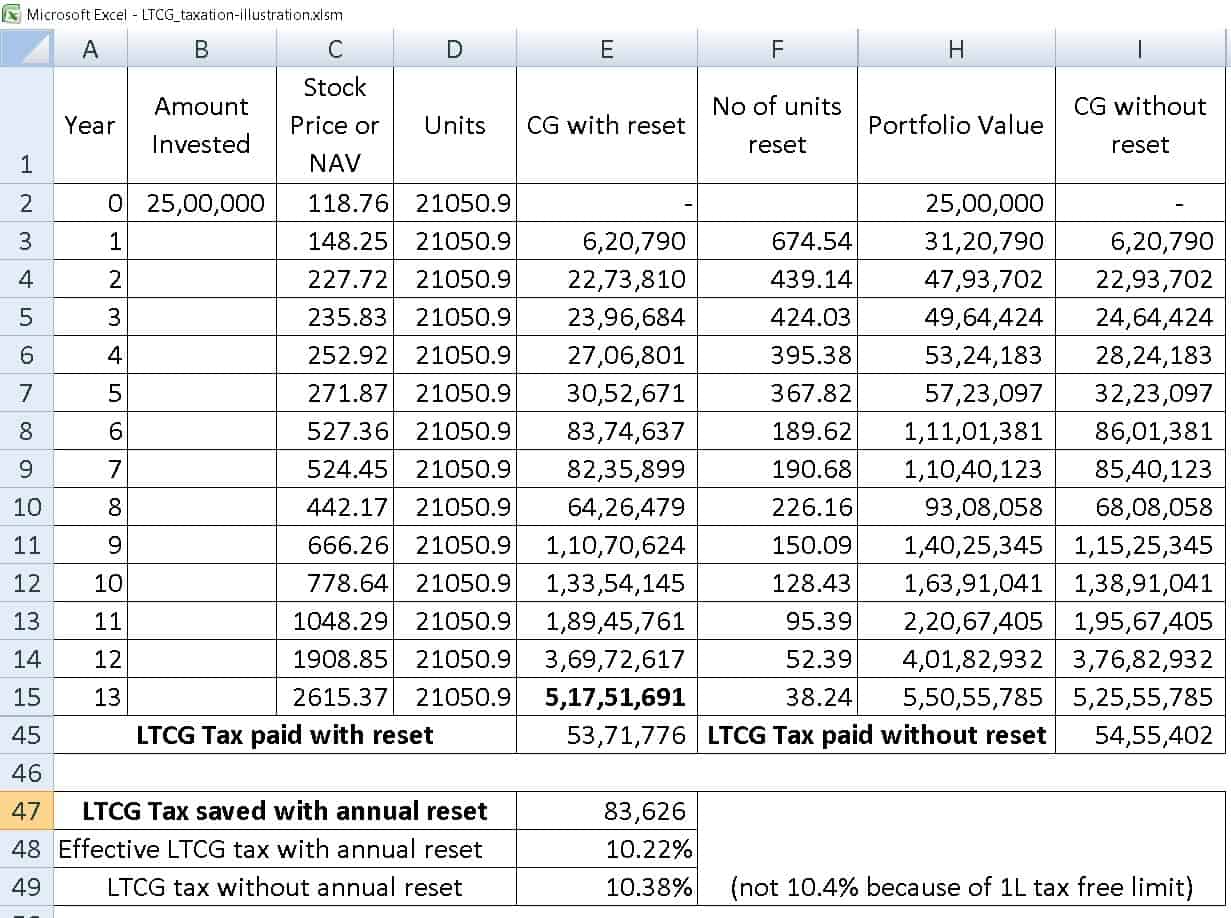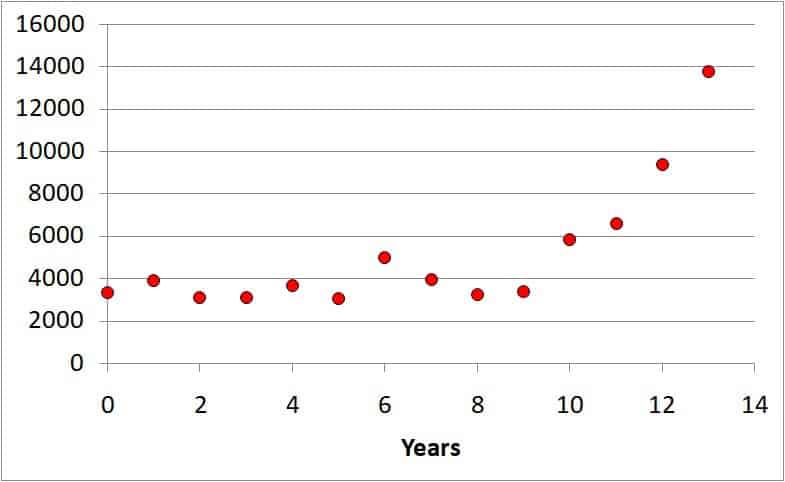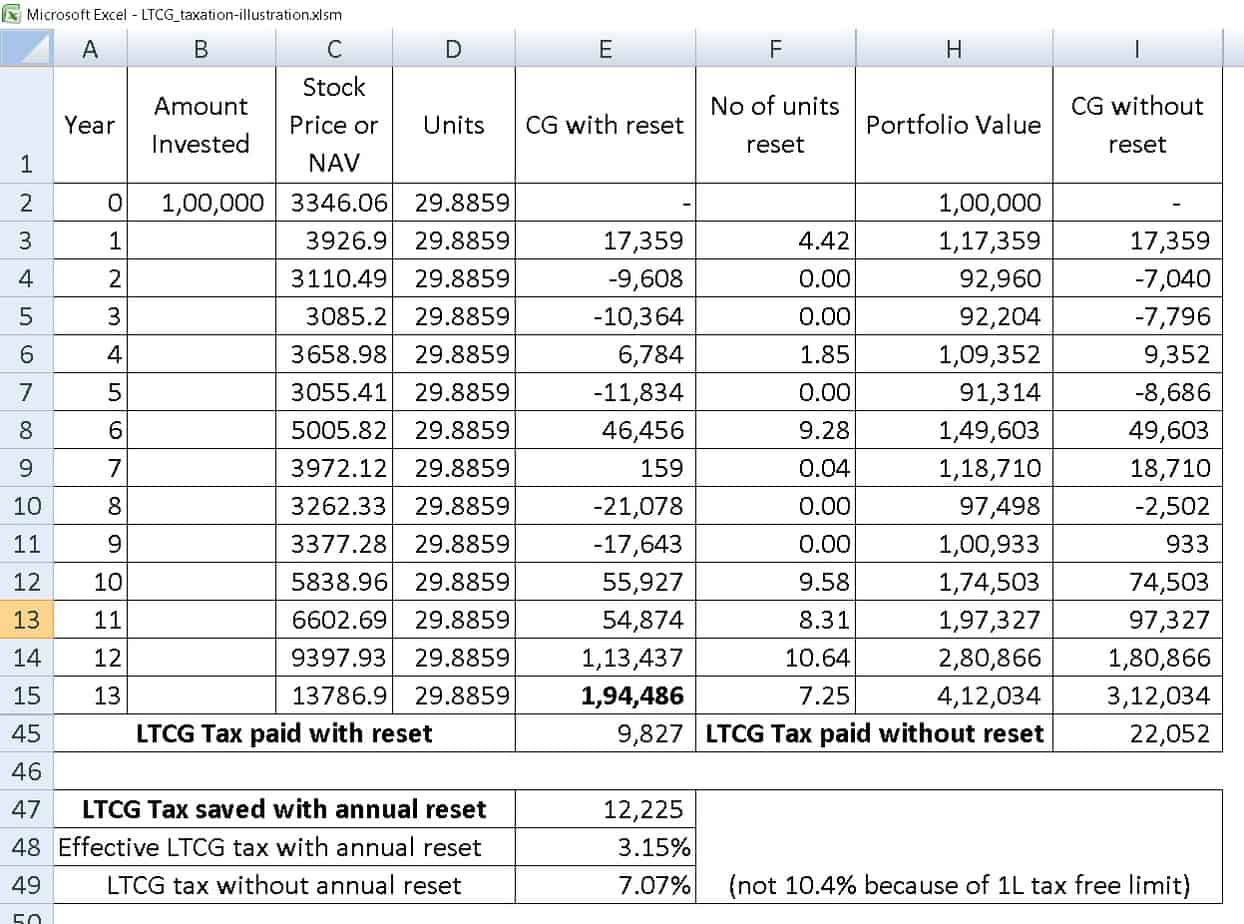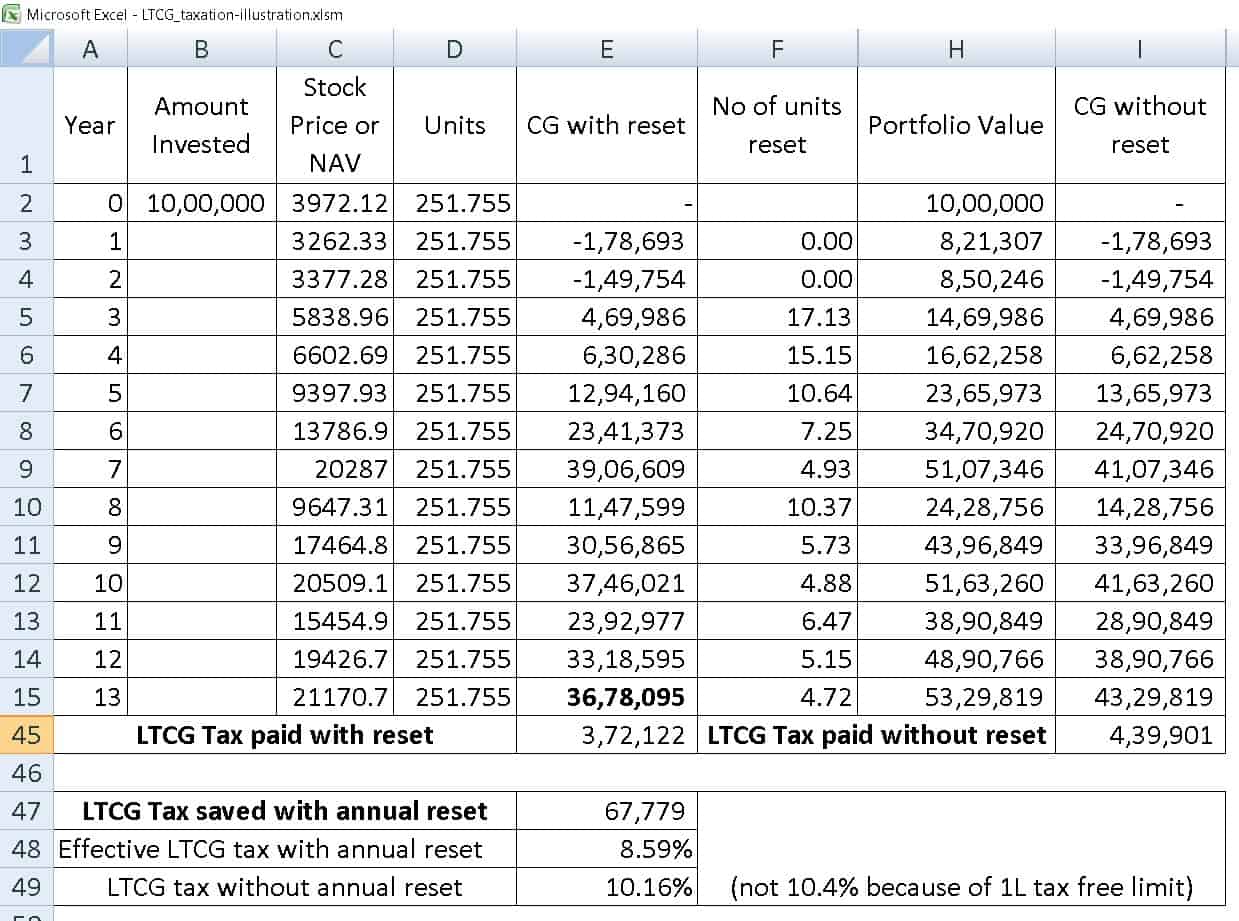Three readers sent us similar requests over the past couple of weeks. One wanted to know if it is worth booking Rs. 1 lakh capital gains from equity or equity mutual funds each year to lower LTCG tax. Another wanted us to illustrate how to compute the necessary units for such an exercise. Yet another wanted a calculator for such tax harvesting.
This article will address the first request: “Should I book Rs. 1 Lakh profit each year to lower Equity LTCG Tax?” We will refer to this as tax-gain harvesting to differentiate it from tax-loss harvesting – offsetting capital gain with an allowed capital loss. See: How to use MF, stock losses to reduce your tax burden (tax-loss harvesting).
Why are investors considering booking profits each year? How does it lower Equity LTCG tax?
Let us start with this simple example: Suppose you invest Rs. 10,000 in a mutual fund or stock at a NAV of Rs. 1/unit (assume this investment is made on or after February 1st, 2018, so no grandfathering confusion).
So you get 10,000 units. After one year, the NAV = 2 per unit. So your portfolio value = 20,000.
The capital gain(CG) = no of units (current price – buying price) = 10000 x (2-1) = 10,000
Now, you decide to redeem 5000 units for Rs. 2 per unit and immediately buy it back (not practical, but hey, anything works in Excel!).
Units are redeemed on a first-in and first-out basis. As of now, all the 10,000 units were purchased at the same time, so no problem.
You redeem 5000 x 2 = 10,000 and buy it back. We will call this profit-booking or resetting.
After one year, the Nav = 3 per unit. (real-life volatility will make a big difference to booking profits).
Suppose you had NOT booked profits (no reset),
Then
CG = 10,000 X ( 3-1) = 20,000
Because you did a reset,
CG(reset) = 5000 x (3-1) + 5000 x(3-2). Do not move forward until you understand this!!
5000 units which were redeemed at NaV = 2 and reinvested at NAV =2 will have a CG = 5000 x (3-2).
The untouched units have a CG = 5000 x (3-1).
CG(reset) = 10,000+5000 = 15,000.
Now the NAV = 3. Total units = 10,000.
Your CG(reset) is 15,000. You redeem this at NAV =3 and reinvest at NAV =3 (2nd reset).
After one more year, the NAV = 4
CG(no reset) = 10000 x (4-1) = 30,000
CG(with reset) = 5000 x(4-3) + 5000 x (4-2). Why? Again do not move forward until you understand!
Redemption is on a first-in, first-out basis. When you did the second rest, you pulled out the oldest 5000 units (purchased at Nav =1 per unit) and repurchased them at a Nav of Rs. 3 per unit.
So for these units the CG(reset) = 5000 x (4-3). Now there are an additional 5000 units purchased at NAV =2 during the first reset. For this the CG(reset) = 5000 x (4-2)
So in total, CG(with reset) = 5000 x(4-3) + 5000 x (4-2). = 5000 + 10000 = 15,000
With the first reset, the effective CG was lower by 5000. After the second reset, it is now lower by 15000. Again, don’t get too excited. Patience is virtuosity.
This is the summary of what we have discussed above. Again, take your time and take it in.
The 3750 units in year 3 are only for the year 4 CG calculation, so don’t worry about it.
If you are ready for the big picture, let us get to it.
Please note that I have only considered a single lump sum investment made on or after February 1st 2018. So no grandfathering business.
Equity LTCG Tax: Illustration 1 (no volatility)
After 13 years of this resetting gymnastics, we have saved a grand sum of Rs. 3,120. This benefit is the same as refusing to surrender a policy, making it paid, and getting the accrued bonus that will stay dormant after many years.
Okay, so the NAV growth assumed above was nice and straight. Let us add some volatility and see what happens.
Equity LTCG Tax: Illustration 2 (10K investment + volatility)
Let us try this price sequence.
So now, we have a savings of 11,463 after 13 years. Many new investors with small portfolios and not aware of market swings are likely to call this “a big amount”. Well, some things must be experienced and cannot be explained in words. If you think this is a great saving, I wish that you soon become a crorepati and lose or gain lakhs in the market daily. Then you will recognise this “saving” is peanuts. It is a rite of passage that must be experienced.
Now let us increase the investment 10K –> 1 Lakh —> 5 Lakh —> 10 Lakh —> 25 Lakh for the same volatility sequence.
Equity LTCG Tax: Illustration 2a (1 Lakh investment)
Notice how much the tax difference has reduced! Keep an eye on that below. As your portfolio grows, it is a waste of time trying to figure out how much you redeem because the reward per year will be comparable to or smaller than daily market gains or losses!
Equity LTCG Tax: Illustration 2b (5 Lakh investment)
Equity LTCG Tax: Illustration 2c (10 Lakh investment)
Equity LTCG Tax: Illustration 2d (25 Lakh investment)
As I said, notice the tax rate difference as the money at stake increases! Let us get rich soon, people!
Equity LTCG Tax: Illustration 3(1Lakh investment)
Now let us try this price sequence (these are real Sensex annual movements) with a one lakh investment.
Notice the losses. No resetting was done when there were losses.
Equity LTCG Tax: Illustration 3a(1Lakh investment)
Another sequence.
Moral: When the market is rocky and annual (FY) losses are large, you do not often reset. The gain from resetting is significant (the irony!). The situation is the same with timing the market: volatility will typically be reduced, but higher returns depend on the price sequence.
Resetting will always reduce capital gains, but the effort does not provide a commensurate reward when the market zooms up. If the market is rocky, then yes, it has its rewards. Over the “long term”, there is a reasonable chance that the market will not be rocky, so tax harvesting is unlikely to make a difference.
unlike this simple study, you will have many instruments and invest multiple times a year. And if you have been investing for a few years now, the 31st Jan grandfather rule will reduce your losses significantly even if you did not reset. As your portfolio grows, the resetting benefit will not amount to much.
Many investors will opt for a reset (tax gain harvesting), but let us at least acknowledge that it is “behavioural” and not “logical.”
For the same rocky sequence, consider a 10 lakh investment.
Equity LTCG Tax: Illustration 3b(10Lakh investment)
Notice the drop in the benefits of resetting as you get richer. Yes, many of us are not rich today, but that doesn’t mean it will be the case forever! We recommend focussing on increasing income, aggressive investing and having a long term view of life and our net worth instead of focusing on petty benefits as tax gain harvesting. Also see: Want To Get Rich? Write Yourself A One Crore Cheque!
Do share this article with your friends using the buttons below.
Use our Robo-advisory Excel Tool for a start-to-finish financial plan! ⇐ More than 1000 investors and advisors use this!
- Follow us on Google News.
- Do you have a comment about the above article? Reach out to us on Twitter: @freefincal or @pattufreefincal
- Join our YouTube Community and explore more than 1000 videos!
- Have a question? Subscribe to our newsletter with this form.
- Hit ‘reply’ to any email from us! We do not offer personalized investment advice. We can write a detailed article without mentioning your name if you have a generic question.
Explore the site! Search among our 2000+ articles for information and insight!
About The Author
 Dr M. Pattabiraman(PhD) is the founder, managing editor and primary author of freefincal. He is an associate professor at the Indian Institute of Technology, Madras. He has over nine years of experience publishing news analysis, research and financial product development. Connect with him via Twitter or Linkedin or YouTube. Pattabiraman has co-authored three print books: (1) You can be rich too with goal-based investing (CNBC TV18) for DIY investors. (2) Gamechanger for young earners. (3) Chinchu Gets a Superpower! for kids. He has also written seven other free e-books on various money management topics. He is a patron and co-founder of “Fee-only India,” an organisation for promoting unbiased, commission-free investment advice.
Dr M. Pattabiraman(PhD) is the founder, managing editor and primary author of freefincal. He is an associate professor at the Indian Institute of Technology, Madras. He has over nine years of experience publishing news analysis, research and financial product development. Connect with him via Twitter or Linkedin or YouTube. Pattabiraman has co-authored three print books: (1) You can be rich too with goal-based investing (CNBC TV18) for DIY investors. (2) Gamechanger for young earners. (3) Chinchu Gets a Superpower! for kids. He has also written seven other free e-books on various money management topics. He is a patron and co-founder of “Fee-only India,” an organisation for promoting unbiased, commission-free investment advice.
Our flagship course! Learn to manage your portfolio like a pro to achieve your goals regardless of market conditions! ⇐ More than 3000 investors and advisors are part of our exclusive community! Get clarity on how to plan for your goals and achieve the necessary corpus no matter what the market condition is!! Watch the first lecture for free! One-time payment! No recurring fees! Life-long access to videos! Reduce fear, uncertainty and doubt while investing! Learn how to plan for your goals before and after retirement with confidence.
Our new course! Increase your income by getting people to pay for your skills! ⇐ More than 700 salaried employees, entrepreneurs and financial advisors are part of our exclusive community! Learn how to get people to pay for your skills! Whether you are a professional or small business owner who wants more clients via online visibility or a salaried person wanting a side income or passive income, we will show you how to achieve this by showcasing your skills and building a community that trusts you and pays you! (watch 1st lecture for free). One-time payment! No recurring fees! Life-long access to videos!
Our new book for kids: “Chinchu gets a superpower!” is now available!

Most investor problems can be traced to a lack of informed decision-making. We have all made bad decisions and money mistakes when we started earning and spent years undoing these mistakes. Why should our children go through the same pain? What is this book about? As parents, what would it be if we had to groom one ability in our children that is key not only to money management and investing but to any aspect of life? My answer: Sound Decision Making. So in this book, we meet Chinchu, who is about to turn 10. What he wants for his birthday and how his parents plan for it and teach him several key ideas of decision making and money management is the narrative. What readers say!

Must-read book even for adults! This is something that every parent should teach their kids right from their young age. The importance of money management and decision making based on their wants and needs. Very nicely written in simple terms. – Arun.
Buy the book: Chinchu gets a superpower for your child!
How to profit from content writing: Our new ebook for those interested in getting side income via content writing. It is available at a 50% discount for Rs. 500 only!
Want to check if the market is overvalued or undervalued? Use our market valuation tool (it will work with any index!), or you buy the new Tactical Buy/Sell timing tool!
We publish monthly mutual fund screeners and momentum, low volatility stock screeners.
About freefincal & its content policy Freefincal is a News Media Organization dedicated to providing original analysis, reports, reviews and insights on mutual funds, stocks, investing, retirement and personal finance developments. We do so without conflict of interest and bias. Follow us on Google News. Freefincal serves more than three million readers a year (5 million page views) with articles based only on factual information and detailed analysis by its authors. All statements made will be verified from credible and knowledgeable sources before publication. Freefincal does not publish any paid articles, promotions, PR, satire or opinions without data. All opinions presented will only be inferences backed by verifiable, reproducible evidence/data. Contact information: letters {at} freefincal {dot} com (sponsored posts or paid collaborations will not be entertained)
Connect with us on social media
Our publications
You Can Be Rich Too with Goal-Based Investing
 Published by CNBC TV18, this book is meant to help you ask the right questions and seek the correct answers, and since it comes with nine online calculators, you can also create custom solutions for your lifestyle! Get it now.
Published by CNBC TV18, this book is meant to help you ask the right questions and seek the correct answers, and since it comes with nine online calculators, you can also create custom solutions for your lifestyle! Get it now.
Gamechanger: Forget Startups, Join Corporate & Still Live the Rich Life You Want
 This book is meant for young earners to get their basics right from day one! It will also help you travel to exotic places at a low cost! Get it or gift it to a young earner.
This book is meant for young earners to get their basics right from day one! It will also help you travel to exotic places at a low cost! Get it or gift it to a young earner.
Your Ultimate Guide to Travel
 This is an in-depth dive analysis into vacation planning, finding cheap flights, budget accommodation, what to do when travelling, and how travelling slowly is better financially and psychologically with links to the web pages and hand-holding at every step. Get the pdf for Rs 199 (instant download)
This is an in-depth dive analysis into vacation planning, finding cheap flights, budget accommodation, what to do when travelling, and how travelling slowly is better financially and psychologically with links to the web pages and hand-holding at every step. Get the pdf for Rs 199 (instant download)

